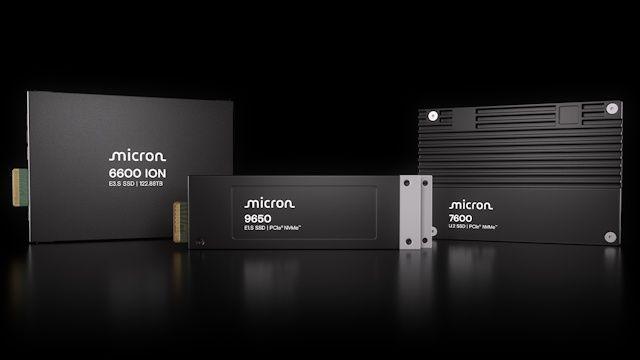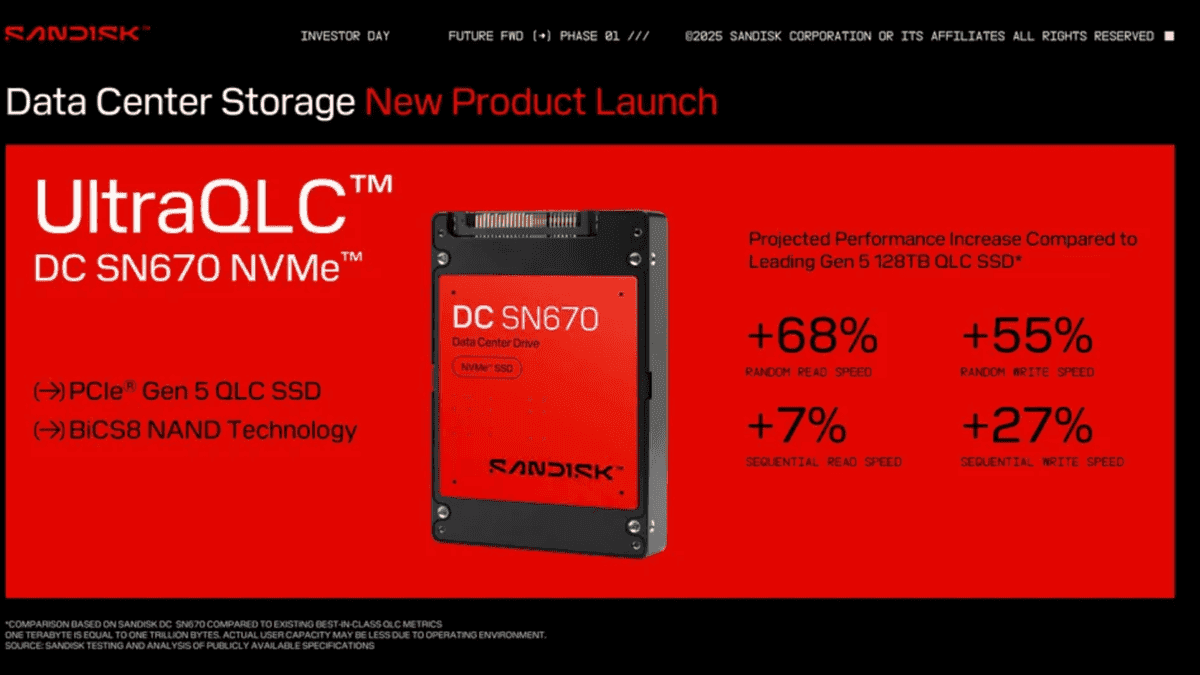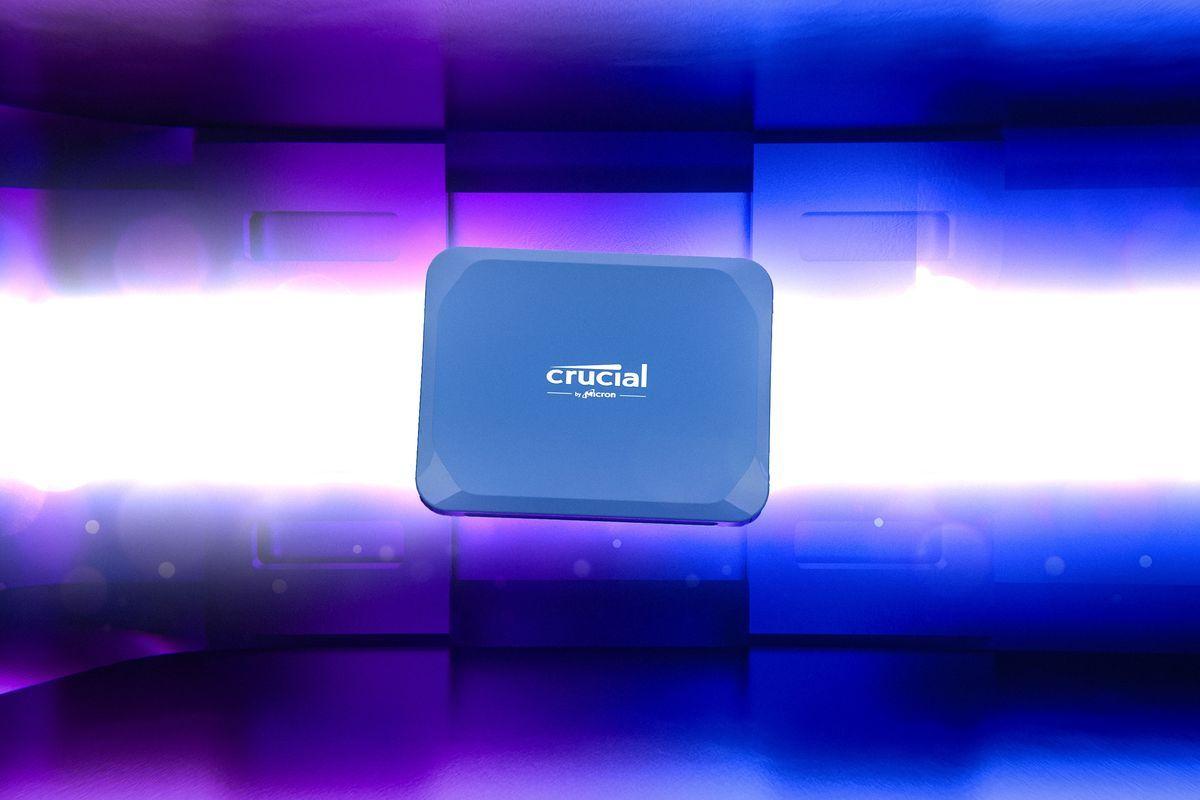Micron Unveils World's First PCIe 6.0 SSD, Revolutionizing Data Center Storage
8 Sources
8 Sources
[1]
Micron's industry-first PCI 6.0 SSD promises sequential reads up to 28,000 MB/s -- 245 TB SSD also coming for those who need capacity more than cutting-edge speed
Micron this week announced its 9650 SSD, the industry's first solid-state drive with a PCIe 6.0 x4 host interface aimed at performance-hungry workloads and offering unprecedented sequential read speed and random performance. In addition, the company formally introduced its 6600 ION family of SSDs with capacities of up to 245 TB. Micron's data center-grade 9650 SSD is based on a proprietary controller designed in-house and the company's 9th Generation 276-layer 3D TLC NAND with a 3.6 GT/s interface. The PCIe Gen6 drive promises a sequential read speed of up to 28,000 MB/s and a sequential write speed of up to 14,000 MB/s, which by far exceeds the capabilities of the best SSDs with a PCIe 5.0 x4 interface. As for random performance, the drive is speced for up to 5.5M read IOPS, which is a record, and up to 0.9M write IOPS, which is a moderate result for an enterprise-grade SSD. For now, Micron positions its 9650 SSD primarily for AI servers that need extreme performance both for sequential reads and (more importantly) random reads. The drives will be available in E1.S (9.5mm and 15mm) as well as E3.S 1T form-factors, with some drives being friendly to liquid cooling systems for consistent performance under high loads. Micron already demonstrated its 9650 SSDs with Astera Labs and Broadcom at various trade shows, including Computex. The drive is meant to communicate in peer-to-peer PCIe 6.0 mode at 64 GT/s with Nvidia's Blackwell GPUs using Astera's or Broadcom's retimers and switches without CPU intervention, which is important both for AI training and inference workloads. "With up to 5.5 million IOPS for random reads, the Micron 9650 is purpose-built for AI pipelines' high-throughput, low-latency demands," said Arunkumar Narayanan, senior vice president of Compute and Networking, Infrastructure Solutions Group (ISG) at Dell Technologies. "This product helps ensure GPUs remain continuously fed with data, minimizing idle cycles and maximizing system efficiency. Combined with Dell's advanced server architecture, this innovation empowers enterprises to unlock new levels of performance and insight." In addition to the high-performance 9650 SSD with a PCIe 6.0 x4 interface, Micron also announced its 6600 ION SSD family that is designed for high-density, power-efficient storage in AI and hyperscale data centers. The 6600 ION drives are based on a platform with a PCIe 5.0 x4 host interface and Micron's 276-layer G9 3D QLC NAND to enable up to 14,000 MB/s sequential read speed as well as up to 2M random read IOPS. The drives will be initially available in capacities of 30.72TB, 61.44TB, and 122.88TB, and offered in E3.S 1T (7.5mm) and U.2 (15mm) form factors. But in the first half of 2026, the company will also offer a 245TB flavor of its 6600 ION SSD. Micron's 6600 ION drives are optimized for capacity-centric workloads, not peak IOPS, and achieve 4.9 TB per watt, making them 37% more power-efficient than HDDs, according to the company. The SSD consumes 5W idle and draws up to 25W under heavy loads. Samples of Micron's 9650 SSD are shipping now to customers. Samples of the 122TB 6600 ION SSD will begin shipping in E3.S and U.2 form factors later in Q3 2025. A 245TB version of the 6600 ION is scheduled for release in the first half of 2026.
[2]
World's first ultra-fast PCIe 6.0 SSD arrives, but it's not for you
Micron's first PCIe 6.0 SSD doubles the read speeds of today's super-fast PCIe 5.0 SSDs. Move over, PCI Express 5.0! Micron has shipped the first PCI Express 6.0 SSD, ramping up read and write speeds to unprecedented levels. The bad news? It's not for PCs. This week, Micron shipped the Micron 9650 SSD, the world's first PCIe 6.0 SSD, designed for AI training and inference workloads. Unfortunately, those tasks take place in AI data centers, not home PCs. Micron will ship the drive in both a PRO (read-intensive) and MAX (write-intensive) configuration, with capacities ranging from 6.4TB to 30.72TB, depending on which flavor a customer buys. Technically, the drives use a PCI Express 6.2 interface, connecting to Micron's six-plane, ninth-generation (G9) flash memory. The kicker, though, is the performance. The Micron 9650 SSD family performs sequential reads of 28,000 MB/s and sequential writes of 14,000 MB/s (which is 100 percent higher and 40 percent higher, respectively, than Micron's previous generation of SSDs). Now compare that to one of our best SSDs, such as the Teamgroup Z540, a PCI Express 5.0 drive: sequential reads are only about 9,000 to 12,000 MB/s, with write speeds of about the same. Micron's 9650 reads data at about double the rate of the Teamgroup drive. Micron's 9650 also performs random reads of 5.5 million IOPS and performs random writes of 900,000 IOPS. Micron says that the endurance of the drive starts at 14,016 terabytes written randomly or 58,300 terabytes written sequentially, and goes up from there. The problem with these newer generations of SSDs, though, is heat. Micron's chips are no exception. You're probably used to SSDs that ship with or without heat spreaders. These SSDs include those, with versions of the PRO series that are also optimized for air cooling. But they also include a 9.5mm option designed to be liquid-cooled. Chip nerds can check out Micron's data sheet (PDF) for more information. We've expected the first PCI Express 6.0 devices to ship this year -- and just like that, they've delivered. Keep in mind that these latest SSDs are designed for data centers, though, and not your PC. For that, chipmakers like Intel and AMD will have to commit to supporting PCI Express 6.0 in their chipsets. So far, that hasn't happened.
[3]
The world's first bleeding-edge PCIe 6.0 SSD is here (but not for you)
Micron's first PCIe 6.0 SSD doubles the read speeds of today's super-fast PCIe 5.0 SSDs. Move over, PCI Express 5.0! Micron has shipped the first PCI Express 6.0 SSD, ramping up read and write speeds to unprecedented levels. The bad news? It's not for PCs. This week, Micron shipped the Micron 9650 SSD, the world's first PCIe 6.0 SSD, designed for AI training and inference workloads. Unfortunately, those tasks take place in AI data centers, not home PCs. Micron will ship the drive in both a PRO (read-intensive) and MAX (write-intensive) configuration, with capacities ranging from 6.4TB to 30.72TB, depending on which flavor a customer buys. Technically, the drives use a PCI Express 6.2 interface, connecting to Micron's six-plane, ninth-generation (G9) flash memory. The kicker, though, is the performance. The Micron 9650 SSD family performs sequential reads of 28,000 MB/s and sequential writes of 14,000 MB/s (which is 100 percent higher and 40 percent higher, respectively, than Micron's previous generation of SSDs). Now compare that to one of our best SSDs, such as the Teamgroup Z540, a PCI Express 5.0 drive: sequential reads are only about 9,000 to 12,000 MB/s, with write speeds of about the same. Micron's 9650 reads data at about double the rate of the Teamgroup drive. Micron's 9650 also performs random reads of 5.5 million IOPS and performs random writes of 900,000 IOPS. Micron says that the endurance of the drive starts at 14,016 terabytes written randomly or 58,300 terabytes written sequentially, and goes up from there. The problem with these newer generations of SSDs, though, is heat. Micron's chips are no exception. You're probably used to SSDs that ship with or without heat spreaders. These SSDs include those, with versions of the PRO series that are also optimized for air cooling. But they also include a 9.5mm option designed to be liquid-cooled. Chip nerds can check out Micron's data sheet (PDF) for more information. We've expected the first PCI Express 6.0 devices to ship this year -- and just like that, they've delivered. Keep in mind that these latest SSDs are designed for data centers, though, and not your PC. For that, chipmakers like Intel and AMD will have to commit to supporting PCI Express 6.0 in their chipsets. So far, that hasn't happened.
[4]
This beastly SSD claims 88PB per rack and might change data centers forever by 2026
Micron has announced a major expansion of its storage lineup with a new entry in the high-capacity SSD space, the 6600 ION. The company says this PCIe Gen5-based SSD is now available in a 122TB configuration and is expected to scale up to 245TB in early 2026. The company is positioning its new model as a direct challenge to hard disk drives in hyperscale and enterprise data centers, aiming to offer greater efficiency in terms of power consumption, physical space, and storage density. The 6600 ION is part of a broader portfolio that also includes the 9650 PCIe Gen6 and the 7600 SSD for low-latency tasks. All three products are built on Micron's G9 NAND, which the company claims enable significant performance and capacity gains. "With the industry's first PCIe Gen6 SSD, industry-leading capacities and the lowest latency mainstream SSD -- all powered by our first-to-market G9 NAND -- Micron is not just setting the pace; we are redefining the frontier of data center innovation," said Jeremy Werner, senior vice president and general manager of Micron's Core Data Center Business Unit Micron claims the 6600 ION can deliver up to 88PB per rack which is huge considering that many of its rivals are still below 40PB per rack. With support for up to 36 E3.S SSDs in a 2U server, the design enables up to 4.42PB per server. "With Supermicro's broadest selection of Petascale storage optimized servers supporting up to 36 E3.S SSDs, the Micron 6600 ION enables up to 4.42PB per 2U server delivering the highest density and power efficiency for large capacity AI workloads," said Michael McNerney, senior vice president, Marketing and Network Security at Supermicro. The 6600 ION reportedly delivers a 67% density improvement over previous alternatives. Micron suggests this could become the largest SSD available commercially, allowing data centers to store exabytes of information with improved energy efficiency. However, its role in actually replacing hard drives will depend on long-term endurance, cost-per-terabyte economics, and compatibility across platforms. That said, the 6600 ION reportedly uses only 1 watt per 4.9TB, a figure that undercuts the power draw of traditional HDD arrays. Micron projects that installations scaling to 2 exabytes could result in daily energy savings equivalent to powering 124 U.S. homes. These claims point to significant operational savings, but large-scale deployment will depend on more than just power metrics. As Micron eyes leadership in fastest SSD and largest SSD categories, the actual shift from HDDs will rely on sustained performance under pressure and meaningful cost advantages across the board.
[5]
This wild SSD from Micron hits record-breaking speeds and ships with industrial form factors your gaming rig can't even recognize
The 7600 SSD delivers ultra-low latency, yet it still depends on how workloads behave in reality Micron has introduced what it describes as, "the world's first PCIe Gen6 data center SSD," with claims of as-yet-unmatched performance tailored for modern AI workloads. The 9650 SSD reportedly hits sequential read speeds of up to 28 GB/s and sequential write speeds of up to 14 GB/s. However, it comes in industrial-grade E3.S and E1.S form factors, making it incompatible with standard desktop PCs, limiting its direct accessibility to broader consumer markets. This new model targets high-intensity AI environments, offering 5.5 million IOPS in random read performance and up to 900K IOPS for random writes. Micron's 9650 improves on Gen5 SSDs with up to 25% and 67% greater energy efficiency for random writes and reads. It also incorporates liquid cooling options for dense server configurations, and its reduced power draw and emissions support both performance gains and sustainability efforts in data centers. "With the industry's first PCIe Gen6 SSD, industry-leading capacities and the lowest latency mainstream SSD - all powered by our first-to-market G9 NAND -- Micron is not just setting the pace; we are redefining the frontier of data center innovation," said Jeremy Werner, senior vice president and general manager of Micron's Core Data Center Business Unit. While these specifications may sound impressive on paper, the real test will be in sustained, real-world workloads under diverse operating conditions. Several vendors have highlighted its potential in supporting inference pipelines and retrieval-augmented generation, suggesting the 9650 could serve as a key infrastructure component for GPU-based servers. Still, wider adoption will likely hinge on pricing, reliability, and actual ecosystem integration. Alongside the 9650, Micron also unveiled its 7600 SSD based on PCIe Gen5 and the Micron 6600 ION SSD, which focuses on capacity. The 7600 claims to deliver sub-1 millisecond latency on demanding database applications like RocksDB. With read speeds reaching 12 GB/s, the 7600 outperforms existing Gen5 SSDs in metrics such as random writes and energy efficiency. But the claims of having the fastest SSD must be balanced against actual deployment flexibility and sustained workload performance. "Micron's cutting-edge storage technologies showcase the importance of fast, efficient storage as AI workloads continue to redefine infrastructure requirements," said Raghu Nambiar, corporate vice president, Data Center Ecosystems and Solutions, AMD.
[6]
Almost a full year after announcing it, Micron finally launches the world's first PCIe 6.0 SSD with up to 28 GB/s sequential read speeds
You're not going to be sticking one in your gaming PC, though, no matter how hard you try to jam it in. It's been three and a half years since the specifications for PCIe 6.0 were finalised and practically a full year since the first product to use the ultra-fast interface was announced, but the very first Gen 6 SSD is now finally ready to buy. Unless you're a PC gamer, that is, because Micron's new 9650 NVMe SSD is for AI servers only. Version 6 of PCI Express was rubberstamped back in January 2022, and given its ultra-fast data transfer rates, it was obvious from the beginning that it was never going to appear first in the consumer market. Utilising PAM4 signalling (previously used by Micron for its GDDR6X VRAM chips for some of Nvidia's RTX 30-series graphics cards), each PCIe 6.0 lane can transfer 64 Gbps, bidirectionally. Consumer-grade SSDs use four PCIe lanes to transfer data back and forth (server-grade models can use more lanes, depending on the socket type used), so the theoretical limit for a Gen 6 M.2 SSD would be 32,000 MB/s. To put that into perspective, the best PCIe 5.0 gaming SSD you can buy right now tops out at 14,900 MB/s. Micron announced its new PCIe 6.0 SSD last August, and it's a little odd that the company has taken almost an entire year to actually get the drive to market. But no matter, the 9650 NVMe is here at last and boasts all kinds of ridiculous numbers to make you go 'ooh' and 'aah' and 'I want one'. First up, the capacities on offer. The smallest is a mere 6.4 TB in size, but since that's only enough to store around 50 copies of Baldur's Gate 3, Micron's new drive goes all the way up to 30.72 TB in capacity. It actually offers two variants of the 9650, a Pro model that's "read-intensive, one drive write per day", and a Max version for "mixed-use, three drive writes per day". Both sport peak sequential data reads of up to 28,000 MB/s (roughly 13% under the PCIe 6.0 limit) and sequential writes of 14,000 MB/s. The 9650 Pro and Max drives differ when it comes to random read/writes, though -- the former peaks at 5,500 and 570 kIOPS respectively, whereas the latter's figures are 5,500 and 900 kIOPs. A SanDisk WD_Black SN8100 has peak random read/writes of 2,300 and 2,400 kIOPs, but a gaming SSD will undergo far more random accesses than any AI server SSD will. But no consumer SSD can touch the Micron 9650 for endurance -- how does up to 282,600 TBW sound? The SN8100 is 2,400 TBW at best, if you need something to compare it to. Even the worst-case scenario for the 9650 is still over 14,000 TBW. Of course, server-grade SSDs need to be incredibly durable, especially those involved with AI workloads, where incredible quantities of data get written and read every day. Now, while PCIe 6.0 is backwards compatible with PCIe 5.0, you won't be able to jam a Micron 9650 into your gaming PC, even if you could afford one. That's because these drives don't use the M.2 socket and instead use an E1.S or E3.S format. Given that we're only two generations into the PCIe 5.0 era, we won't be seeing anything like the 9650 in a standard PC anytime soon. AMD and Intel won't support PCIe 6.0 in their next round of chips, but there's a small chance that they might for the generation after. However, given the slow uptake of the Gen 5 interface by SSD and graphics card manufacturers, I suspect it will take even longer for Gen 6 to trickle down to the consumer market. In the meantime, all we can do is look at the likes of the Micron 9650 and make vroom, vroom noises. Yes, I know SSDs don't make a sound, but how else is one supposed to show admiration for the ludicrous speeds? Slap it and say, "This beast can read a full Baldur's Gate 3 in less than six seconds"? Pfff, meaningless. Just go vroom.
[7]
Micron 9650 SSD unveiled: world's first Gen6 SSD with up to 28GB/sec read speeds
TL;DR: Micron's new 9650 Gen6 SSD delivers up to 28GB/sec read speeds with in-house G9 NAND, offering industry-leading performance, low latency, and improved energy efficiency for next-gen data centers. Alongside the high-capacity 6600 ION and ultra-low latency 7600 Gen5 SSDs, Micron redefines data center storage innovation. Micron has just unveiled the world's first Gen6 SSD with the introduction of its new Micron 9650 Gen6 SSD, capable of up to 28GB/sec reads for next-gen Gen6-ready data centers. The new Micron 9650 Gen6 SSD features its in-house G9 NAND flash, aimed at high performance and low latencies for data center servers. Micron's new family of three SSDs uses vertical integration and its in-house G9 NAND, DRAM, and firmware to ensure that its new SSDs pack leading performance for servers, high capacity, high speeds, lower latencies, all while consuming less power. Micron's new 9650 Gen6 SSD has up to 28GB/sec of sequential read speeds -- twice that of the 14GB/sec capable in Gen5 SSDs -- and up to 14GB/sec in sequential writes. This means that Micron's new 9650 Gen6 SSD has the fastest speeds out of the box, but does it with 25% improved efficiency at random writes, and up to 67% better efficiency at random reads. Next up we've got another enterprise SSD with Micron's new 6600 ION which offers a huge 122TB of capacity and uses the new E3.S interface. The E3.S interface usually taps out at 15.36TB of capacity, but the new 122TB capacity inside of the 6600 ION means that it competes with the E3.L form factor data center SSDs, all inside of a smaller footprint. Micron's new 6600 ION can reach 2.4PB (petabytes) of storage inside of a 1U server, achieved by using 36 of the new Micron 6600 ION SSDs you can reach 4.42PB of storage per 2U server. Micron has massively improved the efficiency of its 6600 ION, consuming only 1W of power per 4.9TB of capacity, making it 37% better in energy efficiency compared to a 3 x 36TB HDD configuration. Lastly, we've got the Micron 7600 SSD which is a new Gen5 SSD solution with ultra-low latency at sub-1ms, making it the fastest data center drive in Gen5 speeds. We've got quick responses with competitive read/write speeds, making the 7600 SSD perfect for those who want the best in AI inference and mixed workloads, available in different form factors including E3.S, U.2, and E1.S. Micron is already shipping its new 9650 Gen6 and 7600 Gen5 SSDs to customers already, with the new 122TB 6600 ION to begin shipping in E3.S and U.2 form factors in Q3 2026. There'll also be a bigger 245TB version of the 6600 ION SSD ready to deploy in 2026. Jeremy Werner, senior vice president and general manager of Micron's Core Data Center Business Unit explains: "With the industry's first PCIe Gen6 SSD, industry-leading capacities and the lowest latency mainstream SSD-all powered by our first-to-market G9 NAND-Micron is not just setting the pace; we are redefining the frontier of data center innovation. This launch cements our leadership in data center SSDs and signals a new era of performance, density and efficiency for our customers". Arunkumar Narayanan, senior vice president of Compute and Networking, Infrastructure Solutions Group (ISG) at Dell Technologies adds: "With up to 5.5 million IOPS for random reads, the Micron 9650 is purpose-built for AI pipelines' high-throughput, low-latency demands. This product helps ensure GPUs remain continuously fed with data, minimizing idle cycles and maximizing system efficiency. Combined with Dell's advanced server architecture, this innovation empowers enterprises to unlock new levels of performance and insight". Kevin Deierling, senior vice president of Networking at NVIDIA said: "Advanced AI reasoning workloads require agents to swiftly access massive volumes of business and internet data. PCIe Gen6 SSDs like the Micron 9650 provide high-speed data access to support accelerated computing performance and efficiency for AI inference and training".
[8]
Micron Unveils 9650 SSD; World's First PCIe Gen6 SSD With Read Speed Of Up To 28GB/s; Unveils Two More High Capacity & Ultra Responsive Data Center Storage Solutions
Gen 6.0 SSDs are officially here as Micron unveils the world's first Gen6 SSD, the 9650, with massive sequential read/write speeds for data centers. One of the leading storage manufacturers, Micron, has today unveiled its new lineup of data center SSDs, offering leading performance over its rivals by deploying its G9 NAND. The new lineup offers three different SSD storage drives, aiming for high performance and low latency on data center systems. By utilizing vertical integration, Micron deployed its controller, G9 NAND, DRAM, and firmware to ensure the SSDs offer leading performance in servers, offering high capacity, high speed, and lower latency while consuming less power. While most of the world hasn't transitioned to the PCIe Gen 5.0 storage solutions, Micron has already laid the foundation for Gen6 storage solutions by unveiling the world's first PCIe 6.0 SSD, known as "9650". The Micron 9650 SSD is a Data Center SSD that offers up to 28 GB/s of sequential read (twice the speed of PCIe 5.0 SSDs) and up to 14 GB/s of sequential write speeds. As per Micron, not only does the 9650 SSD deliver the industry's leading performance out of the box, but it also offers up to 25% better efficiency at random writes and up to 67% better efficiency at random reads. Micron 9650 SSD specialty: With the industry's first PCIe Gen6 SSD, industry-leading capacities and the lowest latency mainstream SSD -- all powered by our first-to-market G9 NAND -- Micron is not just setting the pace; we are redefining the frontier of data center innovation, - Jeremy Werner, SVP and GM, Micron's Core Data Center Business Unit The next enterprise SSD is the 6600 ION, which offers up to 122 TB of storage capacity and uses the E3.S interface. E3.S interface usually offers up to 15.36 TB of capacity, and with a gigantic 122 TB storage size, the E3.S 6600 ION SSD literally competes with E3.L form-factor data center SSDs while retaining a smaller footprint. The Micron 6600 ION SSD can achieve up to 2.4 PetaBytes of storage in a 1U server, and by deploying 36x 6600 ION SSDs, it can achieve up to 4.42 PetaBytes of storage capacity per 2U server. The efficiency is also hugely improved, consuming only 1 watt per 4.9 TB size, making it 37% better in energy efficiency than a 3x 36 TB HDD configuration. The third one is the Micron 7600 SSD, a Gen 5 storage solution with ultra-low latency. With a sub-1ms latency, it's the fastest data center Gen 5.0 SSD, offering quick responses while offering competitive read/write performance. Excellent for AI inference and mixed workloads, 7600 is suitable for most enterprises, and is available in different form factors such as E3.S, U.2, and E1.S. The 9650 Gen 6.0 SSD and 7600 Gen 5.0 SSDs are reportedly shipping to Micron's customers already, while the 122 TB 6600 ION SSD will start shipping in the third quarter of this year in both E3.S and U.2 form factors. Moreover, there will be a 245 TB version of the 6600 ION SSD scheduled for launch in 2026.l
Share
Share
Copy Link
Micron introduces the 9650 SSD, the industry's first PCIe 6.0 solid-state drive, alongside high-capacity 6600 ION SSDs, targeting AI workloads and data center efficiency.
Micron Introduces Groundbreaking PCIe 6.0 SSD
Micron Technology has unveiled the 9650 SSD, marking a significant milestone as the industry's first solid-state drive with a PCIe 6.0 x4 host interface
1
. This cutting-edge drive is designed to cater to performance-hungry workloads, particularly in AI and data center environments, offering unprecedented speed and performance.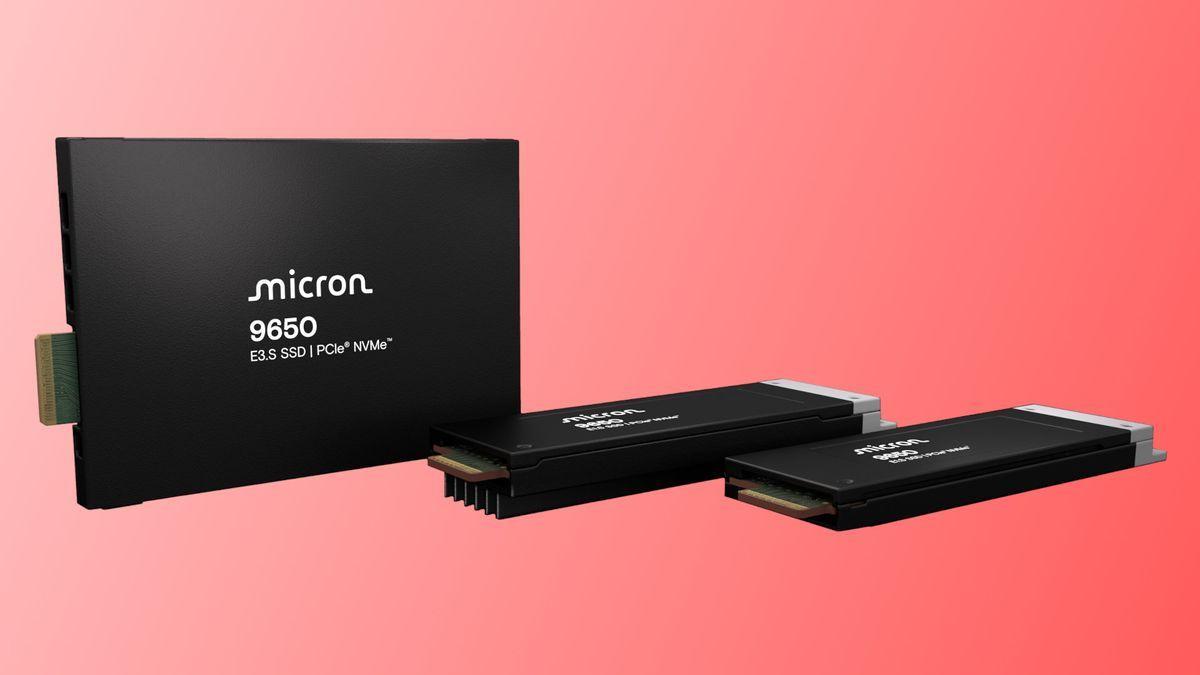
Source: PC Gamer
Unprecedented Performance Specifications
The Micron 9650 SSD boasts impressive specifications that set new benchmarks in the storage industry:
- Sequential read speed: Up to 28,000 MB/s
- Sequential write speed: Up to 14,000 MB/s
- Random read performance: Up to 5.5 million IOPS
- Random write performance: Up to 900,000 IOPS
1
2
These figures represent a substantial leap forward, with read speeds doubling those of current top-tier PCIe 5.0 SSDs
2
.Advanced Technology and Design
The 9650 SSD is built on Micron's proprietary controller and utilizes the company's 9th Generation 276-layer 3D TLC NAND with a 3.6 GT/s interface
1
. Available in E1.S (9.5mm and 15mm) and E3.S 1T form-factors, some variants are compatible with liquid cooling systems to ensure consistent performance under high loads1
3
.AI and Data Center Applications
Micron is positioning the 9650 SSD primarily for AI servers that require extreme performance in both sequential and random read operations. The drive is designed to communicate in peer-to-peer PCIe 6.0 mode at 64 GT/s with NVIDIA's Blackwell GPUs, utilizing Astera's or Broadcom's retimers and switches without CPU intervention
1
4
.Introducing the 6600 ION SSD Family
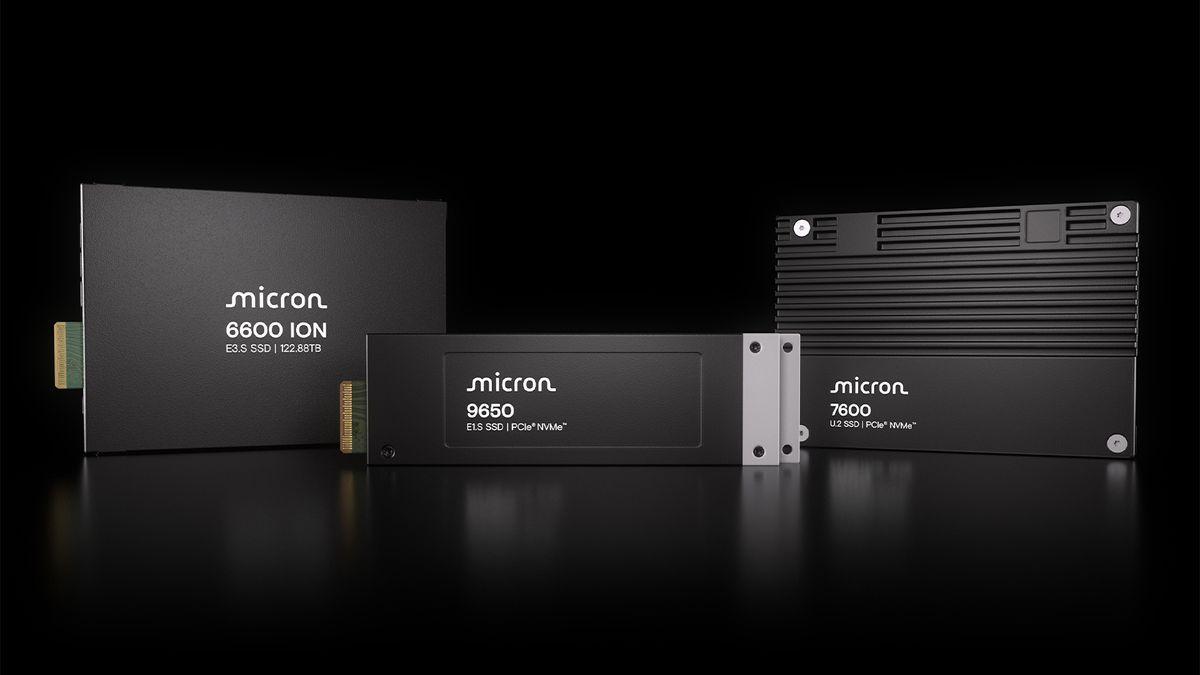
Source: Tom's Hardware
Alongside the high-performance 9650, Micron announced the 6600 ION SSD family, targeting high-density, power-efficient storage in AI and hyperscale data centers
1
4
. Key features of the 6600 ION include:- PCIe 5.0 x4 host interface
- Capacities ranging from 30.72TB to 122.88TB (with a 245TB version planned for 2026)
- Sequential read speeds up to 14,000 MB/s
- Random read performance up to 2 million IOPS
- Power efficiency of 4.9 TB per watt
1
4
Related Stories
Addressing Heat Management Challenges
As SSD performance increases, so does the challenge of heat management. Micron has incorporated various cooling solutions, including heat spreaders and air cooling optimizations. Notably, the 9650 SSD offers a 9.5mm option designed for liquid cooling, addressing the thermal concerns associated with high-performance storage
2
3
.Market Impact and Availability
While these new SSDs represent significant advancements in storage technology, they are primarily targeted at data center and enterprise applications. Consumer PCs will need to wait for chipmakers like Intel and AMD to support PCIe 6.0 in their chipsets before similar performance can be achieved in personal computing
2
5
.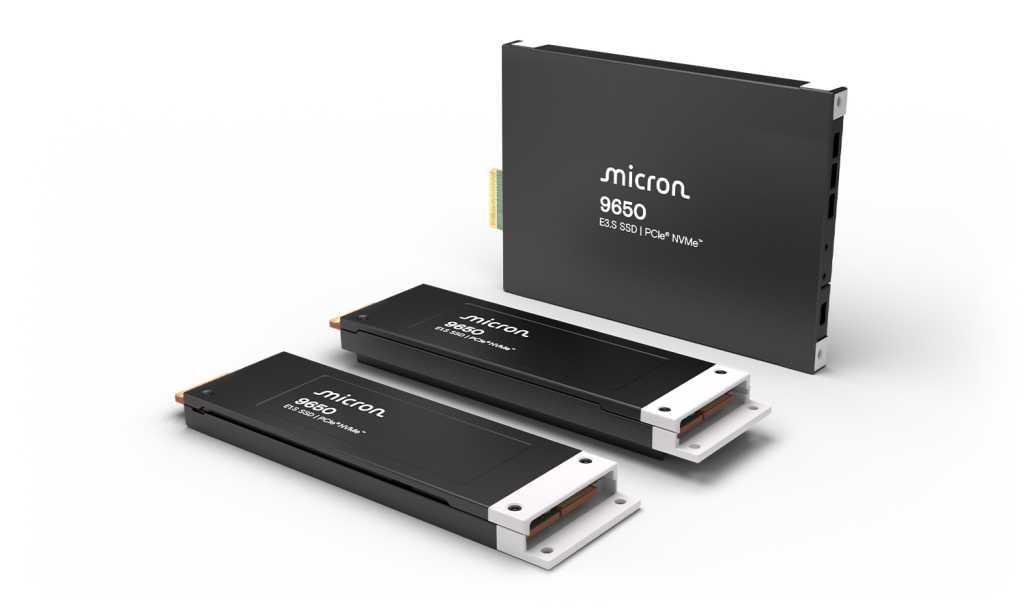
Source: PCWorld
Samples of the Micron 9650 SSD are currently shipping to customers, while the 122TB 6600 ION SSD samples are scheduled for Q3 2025, with the 245TB version planned for the first half of 2026
1
.References
Summarized by
Navi
[1]
Related Stories
Recent Highlights
1
OpenAI releases GPT-5.2 AI model after code red memo signals Google Gemini 3 threat
Technology

2
Disney invests $1 billion in OpenAI, licenses 200+ characters for Sora AI video generator
Technology

3
OpenAI faces wrongful death lawsuit after ChatGPT allegedly fueled murder-suicide tragedy
Policy and Regulation


